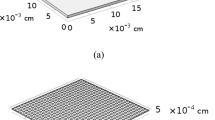Abstract
Surface exchange reactions and diffusion of oxygen in ceramic composites consisting of a dilute and random distribution of inclusions in a polycrystalline matrix (host phase) are modeled phenomenologically by employing the finite element method. The microstructure of the mixed conducting composite is described by means of a square grain model, including grain boundaries of the matrix and interphase boundaries between the inclusions and grains of the host phase. An instantaneous change of the oxygen partial pressure in the surrounding atmosphere may give rise to an oxygen exchange process, i.e., oxidation or reduction of the ceramic composite. Relaxation curves for the total amount of exchanged oxygen are calculated, emphasizing the role played by fast diffusion along the interfaces. The relaxation curves are interpreted in terms of effective medium diffusion, introducing appropriate equations for the effective diffusion coefficient and the effective surface exchange coefficient. When extremely fast diffusion along the grain and interphase boundaries is assumed, the re-equilibration process shows two different time constants. Analytical approximations for the relaxation process and relations for the separate relaxation times are provided for this limiting case as well as for blocking interphase boundaries. Furthermore, conductivity relaxation curves are calculated by coupling diffusion and dc conduction. In the case of effective medium diffusion, the conductivity relaxation curves do not deviate from those for the total amount of exchanged oxygen. On the contrary, the conductivity relaxation curves differ remarkably from the time dependence of the total amount of exchanged oxygen, when the different phases of the composite re-equilibrate with separate time constants.







Similar content being viewed by others
References
Maier J (1995) Prog Solid State Chem 23:171–263
Steele BCH, Hori KM, Uchino S (2000) Solid State Ionics 135:445–450
Ji Y, Kilner JA, Carolan MF (2005) Solid State Ionics 176:937–943
Zhang K, Yang YL, Ponnusamy D, Jacobson AJ, Salama K (1999) J Mater Sci 34:1367–1372
Diethelm S, van Herle J, Sfeir J, Buffat P (2004) Br Ceram Trans 103:147–152
Sase M, Hermes F, Yashiro K, Sato K, Mizusaki J, Kawada T, Sakai N, Yokokawa H (2008) J Electrochem Soc 155:B793–B797
Sase M, Yashiro K, Sato K, Mizusaki J, Kawada T, Sakai N, Yamaji K, Horita T, Yokokawa H (2008) Solid State Ionics 178:1843–1852
Sata M, Eberman K, Eberl K, Maier J (2000) Nature 408:946–949
Peters A, Korte C, Hesse D, Zakharov, Janek J (2007) Solid State Ionics 178:67–76
Gryaznov D, Fleig J, Maier J (2006) Solid State Ionics 177:1583–1586
Gryaznov D, Fleig J, Maier J (2008) Solid State Sci 10:754–760
Bunde A, Dieterich W (2000) J Electroceramics 5:81–92
Knauth P (2000) J Electroceramics 5:111–125
McLachlan DS, Blaszkiewicz M, Newnham RE (1990) J Am Ceram Soc 73:2187–2203
Kalnin JR, Kotomin EA, Maier J (2002) J Phys Chem Solids 63:449–456
Belova IV, Murch GE (2004) Phil Mag 84:17–28
Belova IV, Murch GE (2005) J Phys Chem Solids 66:722–728
Jamnik J, Kalnin JR, Kotomin EA, Maier J (2006) Phys Chem Chem Phys 8:1310–1314
Preis W (2009) J Phys Chem Solids 70:616–621
Preis W (2009) Monatsh Chem 140:1059–1068
Yoo HI, Lee CE (2009) Solid State Ionics 180:326–337
Carslaw HS, Jaeger JC (1959) Conduction of heat in solids. Clarendon, Oxford
Crank J (1975) The mathematics of diffusion. Oxford University Press, Oxford
Preis W, Sitte W (2005) J Phys Chem Solids 66:1820–1827
Preis W, Sitte W (2008) Solid State Ionics 179:765–770
Katsuki M, Wang S, Dokiya M, Hashimoto T (2003) Solid State Ionics 156:453–461
Preis W, Bucher E, Sitte W (2002) J Power Sources 106:116–121
Preis W, Bucher E, Sitte W (2004) Solid State Ionics 175:393–397
Preis W, Holzinger M, Sitte W (2001) Monatsh Chem 132:499–508
Boukamp BA, den Otter MW, Bouwmeester HJM (2004) J Solid State Electrochem 8:592–598
Preis W, Sitte W (2005) J Appl Phys 97:093504
Author information
Authors and Affiliations
Corresponding author
Appendix
Appendix
The effective diffusion coefficient of the polycrystalline matrix (grains of phase 1 and grain boundaries) can be written as
by employing the two-dimensional Maxwell–Garnett relation, where g′ is the volume fraction of grain boundaries in the matrix and s′ is defined by Eq. 5b. If fast grain boundary diffusion is assumed and the thickness of the grain boundaries is much smaller than the grain size, i.e., \( D{\prime} > > {D_1} \) and \( g{\prime} < < 1 \), Eq. A1 can be approximated by
Introducing the area fraction of grain boundaries, \( \varepsilon = \delta /d = g{\prime}/2 \), one arrives at Eq. 17, which has been derived for the effective diffusivity with respect to fast grain boundary diffusion previously [20, 24, 25, 31].
When the heterointerfaces are arbitrarily combined with the inclusions (phase 2), the effective diffusion coefficient, \( {D{\prime}_2} \) is given by
in analogy to relation (A1). In this case g″ is given by \( g{\prime}{\prime} = 4\delta /d = 2\varepsilon \), such that Eq. 18 is obtained assuming D″>> D2 and g″ <<1. For the sake of simplicity grain, boundaries are neglected in the inclusions. However, the extension of the relations for effective medium diffusion to polycrystalline inclusions is straightforward.
Rights and permissions
About this article
Cite this article
Preis, W. Modeling of surface exchange reactions and diffusion in composites including transport processes at grain and interphase boundaries. J Solid State Electrochem 15, 2013–2022 (2011). https://doi.org/10.1007/s10008-010-1223-5
Received:
Revised:
Accepted:
Published:
Issue Date:
DOI: https://doi.org/10.1007/s10008-010-1223-5




